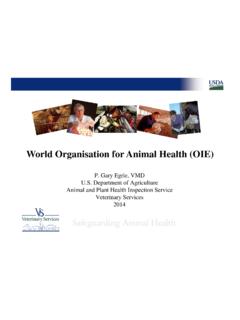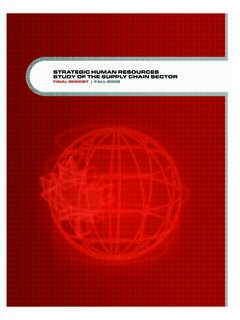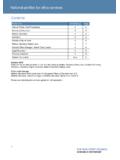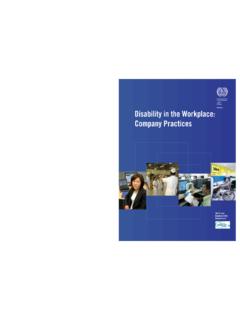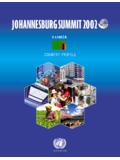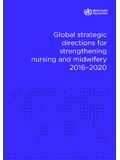Transcription of Climate Change - nas-sites.org
1 Answers to common questions about the science of Climate Change EVIDENCE, IMPACTS, AND CHOICESC limateChangeHow do we know that Earth has warmed? How do we know that humans are causing greenhouse gas concentrations to increase? How do we know the current warming trend isn t caused by the Sun? How do we know that the warming trend is not caused by natural cycles? How much more warming can be expected? How is precipitation expected to Change ? How will sea ice and snow be affected? How will coastlines be affected? How will ecosystems be affected? How will agriculture and food production be affected? How does science inform the response to Climate Change ?RefeRencesNational Research Council, 2010a, Advancing the Science of Climate ChangeNational Research Council, 2010b, Limiting the Magnitude of Climate ChangeNational Research Council, 2010c, Adapting to the Impacts of Climate ChangeNational Research Council, 2011d, Informing an Effective Response to Climate ChangeNational Research Council, 2010e, Ocean Acidification: A national Strategy to Meet the Challenges of a Changing OceanNational Research Council 2011a, Climate Stabilization Targets.
2 Emissions, Concentrations, and Impacts for Decades to MillenniaNational Research Council, 2011c, America s Climate ChoicesFor more information, contact the Board on Atmospheric Sciences and Climate at 202-334-3512 or visit A video based on Part I of this booklet is available at This booklet was prepared by the national Research Council with support from the national Oceanic and Atmospheric Administration (NOAA). It was developed by Nancy Huddleston and designed by Francesca Moghari. Special thanks to Ian Kraucunas, Antonio J. Busalacchi, Jr., Edward J. Dunlea, Robert W. Fri, Laurie Geller, Pamela A. Matson, Damon Matthews, Gerald A. Meehl, Claudia Mengelt, Raymond T. Pierrehumbert, Kimberly A. Prather, John P. Reisman, and Benjamin D. Santer for their helpful CreditsMain cover photo by Michael D.
3 Dudzik; cover thumbnail (bottom) by Fuse; p. 1 by John P. Kelley (Image Bank); p. 17 by Joe McDonald; p. 19 courtesy United States Geological Survey; p. 20 by Randy Well (Stone); p. 23, p. 27 by David Haines; p. 30, Jupiter Images (Comstock); p. 36, kali9. Photo on p. 2 by Mike Waszkiewicz, courtesy national Science Foundation. Nicole Spaulding and Kristin Schild, students from the University of Maine Climate Change Institute, chip out near-surface ice samples as part of research into new methods for sampling the record of polar Climate Change . 2012 national Academy of SciencesAbout the national Research councilThe national Research Council was organized by the national Academy of Sciences in 1916 to associate the broad community of science and technology with the Academy s purposes of furthering knowledge and advising the federal government.
4 The Council has become the principal operating agency of both the national Academy of Sciences and the national Academy of Engineering and is administered jointly by both Academies and the Institute of Medicine. The national Research Council enlists the nation s foremost scientists, engineers, health professionals, and other experts to serve on committees to address scientific and technical aspects of some of the nation s most pressing problems. These experts serve pro bono and are screened for conflicts of interest to ensure that the committee is able to provide impartial and objective advice. Through these committees, the Academies produce about 200 peer-reviewed reports each year that provide thoughtful analysis and helpful direction to policymakers and I.
5 Evidence for Human-Caused Climate Change 2 How do we know that Earth has warmed? 3 How do we know that greenhouse gases lead to warming? 4 How do we know that humans are causing greenhouse gases to increase? 6 How much are human activities heating Earth? 9 How do we know the current warming trend isn t caused by the Sun? 11 How do we know the current warming trend isn t caused by natural cycles? 12 What other Climate changes and impacts have been observed? 15 The Ice Ages 18 Part II. Warming, Climate Changes, and Impacts in the 21st Century and Beyond 20 How do scientists project future Climate Change ? 21 How will temperatures be affected? 22 How is precipitation expected to Change ? 23 How will sea ice and snow be affected?
6 26 How will coastlines be affected? 26 How will ecosystems be affected? 28 How will agriculture and food production be affected? 29 Part III. Making Climate Choices 30 How does science inform emissions choices? 31 What are the choices for reducing greenhouse gas emissions? 32 What are the choices for preparing for the impacts of Climate Change ? 34 Why take action if there are still uncertainties about the risks of Climate Change ? 35 Conclusion 36 Just what is Climate ? Climate is commonly thought of as the expected weather conditions at a given location over time. People know when they go to New York City in winter, they should take a coat. When they visit the Pacific Northwest, they take an umbrella. Climate can be measured at many geographic scales for example, cities, countries, or the entire globe by such statistics as average temperatures, average number of rainy days, and the frequency of droughts.
7 Climate Change refers to changes in these statistics over years, decades, or even progress has been made in increasing our understanding of Climate Change and its causes, and a clearer picture of current and future impacts is emerging. Research is also shedding light on actions that might be taken to limit the magnitude of Climate Change and adapt to its impacts. This booklet is intended to help people understand what is known about Climate Change . First, it lays out the evidence that human activities, especially the burning of fossil fuels, are responsible for much of the warming and related changes being observed around the world. Second, it summarizes projections of future Climate changes and impacts expected in this century and beyond. Finally, the booklet examines how science can help inform choices about managing and reducing the risks posed by Climate Change .
8 The information is based on a number of national Research Council reports (see inside back cover), each of which represents the consensus of experts who have reviewed hundreds of studies describing many years of accumulating evidence. Climate ChangeEvidEncE, impacts, and choicEs2 But how has this conclusion been reached? Climate science, like all science, is a process of collective learning that relies on the careful gathering and analyses of data, the formulation of hypotheses, the development of models to study key processes and make testable predictions, and the combined use of observations and models to test scientific understanding. Scientific knowledge builds over time as new observations and data become available. Confidence in our understanding grows if multiple lines of evidence lead to the same conclusions, or if other explanations can be ruled out.
9 In the case of Climate Change , scientists have understood for more than a century that emissions from the burning of fossil fuels could lead to increases in the Earth s average surface temperature. Decades of research have confirmed and extended this understanding. The overwhelming majority of Climate scientists agree that human activities, especially the burning of fossil fuels (coal, oil, and gas), are responsible for most of the Climate Change currently being for Human-Caused Climate ChangePart I3 Scientists have been taking widespread measure-ments of Earth s surface temperature since around 1880. These data have steadily improved and, today, temperatures are recorded by ther-mometers at many thousands of locations, both on the land and over the oceans.
10 Different research groups, including the NASA Goddard Institute for Space Studies, Britain s Hadley Centre for Climate Change , the Japan Meteorological Agency, and NOAA s national Climate Data Center have used these raw measurements to produce records of long-term global surface temperature Change (Figure 1). These groups work carefully to make sure the data aren t skewed by such things as changes in the instruments taking the measure-ments or by other factors that affect local tempera-ture, such as additional heat that has come from the gradual growth of analyses all show that Earth s average surface temperature has increased by more than F ( C) over the past 100 years, with much of this increase taking place over the past 35 years. A temperature Change of F may not seem like much if you re thinking about a daily or seasonal fluctuation, but it is a significant Change when you think about a permanent increase averaged across the entire planet.

